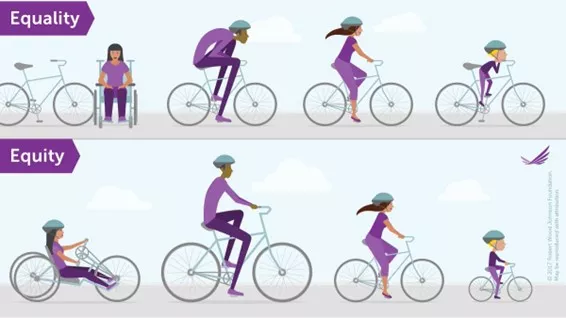
Let's enhance racial equality in the workplace
21 March 2023
Tuesday, 21st March, is International Elimination of Racial Discrimination Day. Established by the UN in 1966 to focus on the “urgency of combatting racism and racial discrimination.” During this blog, we'll explore the types of discrimination and how to create an inclusive and equitable workplace for all.
2023 marks the 75th anniversary of the Universal Declaration of Human Rights (UDHR), which states that "everyone is entitled to all the rights and freedoms, without distinction of any kind, such as race and colour, among others.”
However, 75 years on, racial discrimination still impacts people worldwide.
The laws on racial discrimination
Racial discrimination in the workplace has been illegal in the UK since 1976 under the Race Relations ACT. That ACT has since been replaced by the Equality Act 2010, which lists race as one of the nine protected characteristics.
Within the Equality Act 2010, race is defined or made up of one or more of the following:
-
Colour
-
Ethnic origin or ethnic group
-
National origin
-
Nationality
-
Racial group
Employers are legally bound to follow the ACT or risk facing an employment tribunal or even prosecution – though the latter is rarely imposed.
Types of discrimination
Under the Equality Act 2010, there are multiple definitions of what constitutes discrimination: direct discrimination, indirect discrimination, associative discrimination, perceptive discrimination, victimisation, and harassment.
Download the CIPD factsheet for more guidance and a detailed breakdown of the definitions.
We are, however, going to look further at indirect discrimination, which, according to the CIPD factsheet, occurs when...
A provision, criterion or practice is applied to all, and:
-
It puts a group with a protected characteristic at a disadvantage when compared with another group
-
An individual is put at a disadvantage
-
The employer cannot show it to be a proportionate means of achieving a legitimate aim.
An example of indirect discrimination provided by the CIPD refers to a situation where an employer might specify that job applicants can only be recruited from a particular area. This stipulation could put applicants of ‘certain ethnic origins’ at a disadvantage and see them excluded from the recruitment process.
Unless the employer can strongly justify limiting applicants to specific areas, they would be guilty of indirect discrimination.
Diversity, Equity & Inclusion (DE&I)
One reason we wish to focus further on indirect discrimination is that it’s very much linked to the concept of equity.
Unlike the Equality Act of 2010, an organisation has no legal requirement to follow or create a DE&I policy. It’s best practice and will improve how the business is received by future employees, partners, and clients – but it’s not set in law.
What stands out about the definition given for indirect discrimination is the concept of applying the same ‘provision, criterion or practice’ to all employees. This is the definition of equality because you’re treating everyone the same. Whilst this may seem like the best practice – the Equality Act 2010 champions equal opportunity, after all - it’s not equitable.
In this case, an equal approach is discriminatory – even though it’s unintentional and indirect. What’s needed is equity.
Understanding Equity
We used this same image (created by Robert Wood Johnson Foundation) for our International Women’s Day blog, but it paints such a clear picture of what equity means it’s worth adding here, also.

The image shows that equality uses the ‘same for all’ approach, whereas equity factors in the individual circumstances and needs, giving people the correct provisions to enable them to succeed.
According to the definition of indirect discrimination and using this image as a guide, we can determine that the equal approach would be considered indirect discrimination because it:
-
Puts a protected characteristic at a disadvantage when compared with another group/individual
-
Puts more than one person at a disadvantage
-
Is not a proportionate means to achieving a legitimate aim.
In comparison, the equitable approach takes each person’s needs and provides the appropriate provision to allow them to achieve the same goal.
While the image above focuses on the physical needs of the individuals, we can apply the example to any protected characteristic, including race.
By focusing on a robust Diversity, Equity, and Inclusion policy and embedding it into your company ethos, you’ll create an environment that embodies fair treatment, access, and opportunity by eliminating the barriers that may hinder success. Thus, reducing the risk of indirect discrimination.
What the statistics tell us...
The Equality and Human Rights Commission published their Race report statistics in 2020, outlining what they call a “worrying picture of race inequality” in education, crime, living standards, health care and employment.
In the case of employment, the key stats are as follows:
-
Black workers educated to degree level earn 23.1% less than white workers with equivalent qualifications.
-
In Britain, a significantly lower percentage of ethnic minorities, African or Caribbean or Black people and those of mixed ethnicity worked as managers, directors, and senior officials, compared with White people.
However, whilst this does paint a picture of inequality, the ONS published its ethnicity pay gap report in 2019. While confirming a gap, it shows it's ‘narrowed to its smallest level since 2012 in England and Wales.’
There may be some way to go, but this shows we’re moving in the right direction.
Striving for racial equality
The Equality Act 2010 is a law that all employers need to follow. Still, we believe that when you live and breathe the ethos of Diversity, Equity, and Inclusion, you take what you ‘must do’ to the next level, creating a truly diverse, inclusive, equal, and equitable workplace where all can thrive, and boundaries are removed.
Pluxee UK has been supporting employers for over 60 years, and we continue to make it our mission to help you help your people succeed. Contact an employee wellbeing and engagement expert today to discover how we can help.





